
Diets with high inclusion of corn fermented protein (CFP) may have an excess of Leu, which has a negative impact on the growth performance of pigs. Tryptophan is a precursor of serotonin, which is a neurotransmitter that is critical for feed intake regulation, and excess dietary Leu may reduce synthesis of serotonin in the brain by preventing Trp from being transported to the brain. Reduced serotonin synthesis can result in reduced feed intake and pigs with reduced feed intake due to excess Leu also have reduced growth performance. As a consequence, if diets are formulated based on CFP instead of soybean meal (SBM), diets need to be fortified with extra Trp to account for the reduced efficiency of Trp due to the excess Leu in corn protein. However, a quantitative assessment of how much extra Trp is needed in diets based on CFP instead of SBM has not been conducted. Therefore, an experiment was conducted to test the hypothesis that the optimum Trp:Lys ratio in diets for growing pigs is greater if CFP rather than SBM is used as the protein source in the diets.
Experimental design
Two basal diets based on corn and SBM or corn and CFP were formulated. Both diets had a standardized ileal digestible (SID) Trp: Lys ratio of 10%, which is 60% of the requirement for Trp (NRC, 2012). Both diets also contained 0.90% SID Lys, which is slightly below the requirement for SID Lys (NRC, 2012). All other indispensable AA were included above the requirement (NRC, 2012) in both basal diets. Eight additional diets were formulated by adding crystalline L-Trp to both basal diets at the expense of cornstarch, to generate diets containing 80, 100, 120, or 140% of the SID requirement for Trp. Therefore, the SID Trp:Lys ratio in the diets was 10, 14, 17, 20, and 24% for each protein source.
A total of 320 growing pigs with an initial body weight (BW) of 25.53 ± 2.85 kg were randomly allotted to one of the 10 dietary treatments. There were two blocks of 40 pens with two barrows and two gilts in each pen and four replicate pens per diet in each block for a total of eight replicate pens for each treatment. At the beginning and at the end of the experiment, and after fasting for 4 h, a blood sample was collected from the jugular vein of the barrow in each pen that had a body weight that was closest to the pen average. Blood samples were analyzed for blood urea N and plasma concentration of amino acids.
All data were first analyzed using Proc MIXED in SAS with the pen as experimental unit. Statistical significance and tendencies were considered at P < 0.05 and 0.05 ≤ P < 0.10, respectively. Data were subjected to broken line analysis and non-linear quadratic regression equations were developed to establish inflection points for ADG and BUN for each source of protein. The concentration of Trp that resulted in the first intercept value of the quadratic regression line and the plateau value from the broken line analysis was used to calculate the ideal SID Trp:Lys ratio for ADG and BUN. The average of Trp required to maximize ADG and G:F was considered the Trp requirement of the pigs. A Wilcoxon rank-sum test was used to determine if the requirement estimates for CFP or SBM were different.
Results
Pigs fed the corn-SBM diets had greater (P < 0.05) final BW, ADG, ADFI, G:F ratio, and daily Trp intake than pigs fed corn-CFP diets (Table 1). For pigs fed the corn-SBM diets, the final BW, ADG, ADFI, and daily Trp intake increased (linear and quadratic, P < 0.05) as the SID Trp:Lys ratio increased in the diets. Likewise, G:F ratio increased linearly (P < 0.05) as the SID Trp:Lys level increased. The final BW, ADG, ADFI, G:F ratio, and daily Trp intake of pigs fed the CFP diets also increased (linear and quadratic, P < 0.05) as the SID Trp:Lys ratio increased. Pigs fed the corn-SBM diets had a reduced (P < 0.05) blood urea N on d 28 than pigs fed corn-CFP diets (Table 2). For pigs fed the corn-SBM diets and the corn-CFP diets, the blood urea N on d 28 increased (linear and quadratic, P < 0.05) as the SID Trp:Lys ratio increased in the diets. There were no differences on the Trp plasma concentration on d 28 if the pigs were fed SBM or CFP. However, for pigs fed the corn-SBM diets and the corn-CFP diets, the Trp concentration in plasma on d 28 increased linearly (P < 0.05) as the SID Trp:Lys level increased.
The dietary SID Trp:Lys in the corn-SBM diets to maximize ADG was estimated to be 19.68 and 17.09% by the curvilinear plateau and broken line models, respectively (Figure 1). For BUN, the optimal SID Trp:Lys was estimated to be 16.43 and 14.67% by the curvilinear plateau and broken line models, respectively (Figure 2).
Based on ADG, the optimal SID Trp:Lys in diets based on corn and CFP was estimated to be 21.87 and 18.02% by the curvilinear plateau and broken line models, respectively (Figure 3). For BUN, the optimal SID Trp:Lys was estimated to be 15.65 and 14.66% by the curvilinear plateau and broken line models, respectively (Figure 4). For pigs fed the SBM diets, combined broken-line and quadratic analyses estimated the optimum SID Trp:Lys ratio as 18.95 and 15.54 for ADG and G:F, respectively. For pigs fed the CFP diets, combined broken-line and quadratic analyses estimated the optimum SID Trp:Lys ratio as 20.51 and 15.65 for ADG and G:F, respectively. The optimum SID Trp:Lys for diets containing SBM and CFP was calculated as the average of the two values obtained for ADG and G:F by the curvilinear plateau and broken line models. Thus, the optimum SID Trp:Lys for diets containing SBM and CFP as protein sources was calculated as 17.24 and 18.08% respectively. These values were not different and under the conditions of this experiment, the requirement for Trp was not different in diets based on CFP compared with diets based on SBM. Therefore, the hypothesis for the experiment was rejected. In conclusion, pigs fed diets based on CFP rather than SBM Have reduced growth performance, but the main reason for this does not appear to be a deficiency of Trp.
Key points:
- Including CFP does not change the requirements for Trp in growing pigs.
Table 1. Effect of dietary standardized ileal digestible (SID) Trp:Lys ratios on growth performance and daily Trp intake in growing pigs fed SBM or corn fermented protein1,2
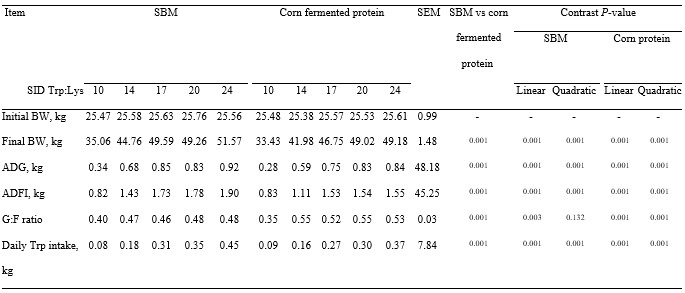
1ADFI, average daily feed intake; ADG, average daily gain; BW, body weight; G:F, gain to feed ratio
2Data are least square means of 8 observations per treatment.
Table 2. Effect of dietary standardized ileal digestible (SID) Trp:Lys ratios on blood urea nitrogen on d 1 and d 28 and amino acid plasma concentration on d 28 in growing pigs fed soybean meal or corn fermented protein
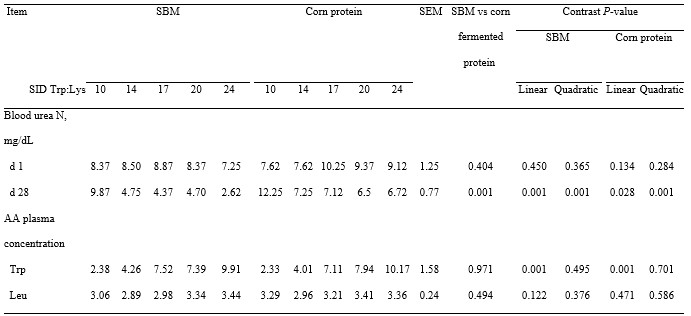
1Data are least square means of 8 observations per treatment.
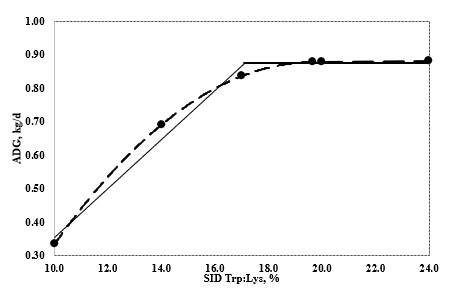
Figure 1. The optimum standardized ileal digestible (SID) Trp:Lys on soybean meal for average daily gain in 25- to 50-kg pigs determined by a curvilinear-plateau model was 19.68% (open line), and by a broken-line model, it was 17.09% (closed line).
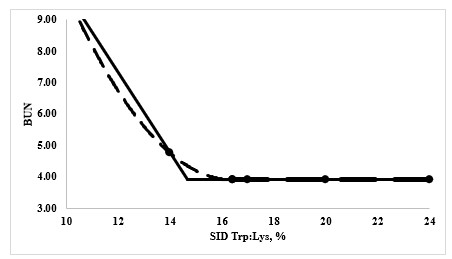
Figure 2. The optimum standardized ileal digestible (SID) Trp:Lys on soybean meal for blood urea N in 25- to 50-kg pigs determined by a curvilinear-plateau model was 16.43% (open line), and by a broken-line model, it was 14.66% (closed line).
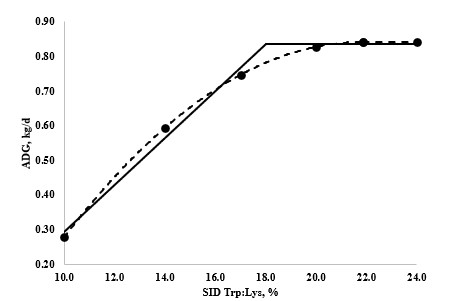
Figure 3. The optimum standardized ileal digestible (SID) Trp:Lys on corn fermented protein for average daily gain in 25- to 50-kg pigs determined by a curvilinear-plateau model was 21.87% (open line), and by a broken-line model, it was 18.02% (closed line).
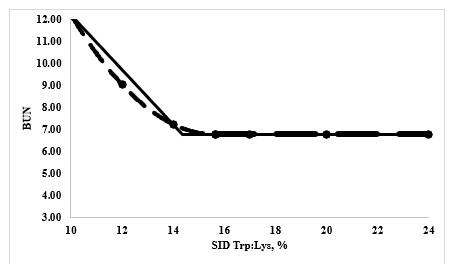
Figure 4. The optimum standardized ileal digestible (SID) Trp:Lys on corn fermented protein for blood urea N in 25- to 50-kg pigs determined by a curvilinear-plateau model was 15.65% (open line), and by a broken-line model, it was 14.37% (closed line).





